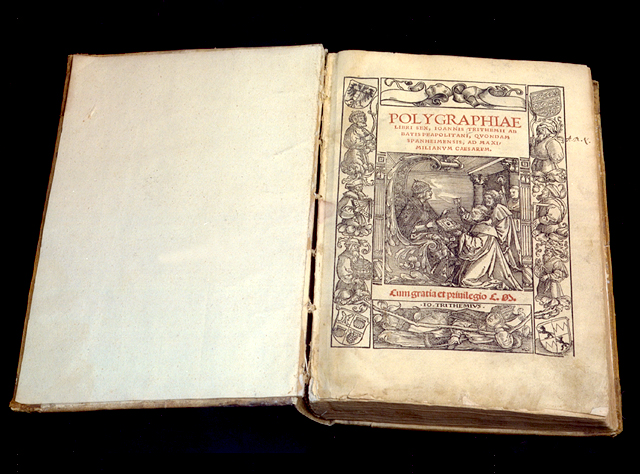 Johannes Trithemius was an Abbot who wrote Steganographia in 1499. It was placed on the Index Librorum Prohibitorum in 1609. This book is in three volumes, and appears to be about black magic - specifically, about using spirits to communicate over long distances. Since the publication of the decryption key to the first two volumes in 1606, they have been known to be actually concerned with cryptography and steganography. Until recently, the third volume was widely still believed to be about magic - but recently the "magical" formulae were shown to be covertexts for yet more cryptography content.
Johannes Trithemius was an Abbot who wrote Steganographia in 1499. It was placed on the Index Librorum Prohibitorum in 1609. This book is in three volumes, and appears to be about black magic - specifically, about using spirits to communicate over long distances. Since the publication of the decryption key to the first two volumes in 1606, they have been known to be actually concerned with cryptography and steganography. Until recently, the third volume was widely still believed to be about magic - but recently the "magical" formulae were shown to be covertexts for yet more cryptography content.
Friday, July 18, 2008
Covered or Hidden Writing
Steganography is the art and science of writing hidden messages in such a way that no one apart from the sender and intended recipient even realizes there is a hidden message. By contrast, cryptography obscures the meaning of a message, but it does not conceal the fact that there is a message. For shorthand see stenography.
 Johannes Trithemius was an Abbot who wrote Steganographia in 1499. It was placed on the Index Librorum Prohibitorum in 1609. This book is in three volumes, and appears to be about black magic - specifically, about using spirits to communicate over long distances. Since the publication of the decryption key to the first two volumes in 1606, they have been known to be actually concerned with cryptography and steganography. Until recently, the third volume was widely still believed to be about magic - but recently the "magical" formulae were shown to be covertexts for yet more cryptography content.
Johannes Trithemius was an Abbot who wrote Steganographia in 1499. It was placed on the Index Librorum Prohibitorum in 1609. This book is in three volumes, and appears to be about black magic - specifically, about using spirits to communicate over long distances. Since the publication of the decryption key to the first two volumes in 1606, they have been known to be actually concerned with cryptography and steganography. Until recently, the third volume was widely still believed to be about magic - but recently the "magical" formulae were shown to be covertexts for yet more cryptography content.
 Johannes Trithemius was an Abbot who wrote Steganographia in 1499. It was placed on the Index Librorum Prohibitorum in 1609. This book is in three volumes, and appears to be about black magic - specifically, about using spirits to communicate over long distances. Since the publication of the decryption key to the first two volumes in 1606, they have been known to be actually concerned with cryptography and steganography. Until recently, the third volume was widely still believed to be about magic - but recently the "magical" formulae were shown to be covertexts for yet more cryptography content.
Johannes Trithemius was an Abbot who wrote Steganographia in 1499. It was placed on the Index Librorum Prohibitorum in 1609. This book is in three volumes, and appears to be about black magic - specifically, about using spirits to communicate over long distances. Since the publication of the decryption key to the first two volumes in 1606, they have been known to be actually concerned with cryptography and steganography. Until recently, the third volume was widely still believed to be about magic - but recently the "magical" formulae were shown to be covertexts for yet more cryptography content.
Subscribe to:
Post Comments (Atom)
1 comment:
Romana Machado, a member of a small group of bay area wackos who called themselves "transhumanists" was an early internet pin-up crush circa 1996. She was an author of the Newton handheld computer's system software, and a program called simply "Stego", which tackled the problem of steganography in compressed GIF87 images (a lossy compression format, tricky). She inspired a lot of my budding interests in cryptology, information security, human computer interaction and interface design. Like Jared Diamond, you sometimes wonder if she's actually a single person or a whole committee of geniuses. I'm betting she's a single person.
Post a Comment